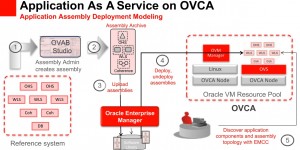Oracle recently upgraded their Virtual Compute Appliance (OVCA) to X4-2. It was launched earlier in 2013, with adoption accelerating. It’s particularly useful for consolidating non-workload specific applications into a single managed environment. Applications may be installed on Windows, Linux, or Solaris.
OVCA is part of Oracle’s portfolio of Converged Infrastructure, also known as Engineered Systems. This portfolio includes:
- Exadata Database Machine and Oracle Database Appliance – for database workloads
- Exalogic Elastic Cloud – for Java workloads
- Big Data Appliance – for unstructured data organization
- Exalytics – for analytics and business intelligence workloads
- SuperCluster – for application and database consolidation
- Virtual Compute Appliance – for quick deployment for hardware and virtualized applications
So the value of Converged Infrastructure over traditional infrastructure is:
- Factory integrated vs. lengthy integration
- Simple and standardized connections vs. hundreds of connections
- Reliability and ease of management vs. ever increasing complexity
More specifically the value of OVCA is:
- Pre-built system thats ready to use with minimal setup
- Reduced integration risk for deploying infrastructure
- Prebuilt templates for integrated application provisioning
- Fully virtualized system with build it software defined networking for increased flexibility.
OVCA may be seen as either an application platform or an infrastructure platform. Primarily it’s a virtualized infrastructure platform, but through the use of templates it may be seen as an application platform.
OVCA as IaaS:
- Monitoring
- Configuration and Change Management
- Provisioning
- Compliance
OVCA as AaaS:
Balancing competing priorities between developers and IT (flexibility vs. standardization).
For Developers:
- Rapid development
- Choice of components and configurations
For IT:
- Certified stacks and frameworks
- Known environments and patterns
- Standardized security, monitoring and management
Oracles reference architecture for OVCA looks like this:
Oracle customers considering consolidation and virtualization clearly have the most to gain from an OVCA solution. However this is applicable to non-Oracle shops too. An organization with mostly Oracle applications may consider OVCA for infrastructure consolidation and integration, but they may have an IBM or Microsoft BI or Portal system that could also be consolidated onto the same hardware. That’s the beauty of this environment, many operating systems are supported, as are diverse workloads. Management is simplified and streamlined.
If your organization has a large number of Java or Database applications, then Exalogic or Exadata may be more appropriate. In my view this solution is ideal for either mid-sized organizations consolidating servers, or for departments within large organizations that want a single environment to host and mange all of their unique applications.




